Saturday 29 September 2018
Bans aren’t the answer to problematic social media accounts

Across the United States, millions of progressives and proponents for equality cheered (or at least had a good chuckle) earlier this month when Facebook, Apple, Spotify, and YouTube collectively banned alt-right conspiracy theorist and hate speech-spewing Alex Jones from their respective platforms. In the words of Spotify, this was done because his brand “expressly and principally promotes, advocates, or incites hatred or violence against a group or individual based on characteristics.” In the words of Apple, “Apple does not tolerate hate speech, and we have clear guidelines that creators and developers must follow to ensure we provide a safe environment…
This story continues at The Next Web
from Social Media – The Next Web https://ift.tt/2OXI5bH
via IFTTT
The ‘always-on’ mentality is terrible for social media managers — here’s how to switch off without getting left behind

If you’re a Social Media Manager, you’ll probably be expected to live and breathe social media. What used to be considered a bit of a cop-out job done on the side is finally being recognized as a profession that requires knowledge and skill. It also often requires the ability to react quickly to the comments, questions and, complaints of a global audience. Someone, somewhere, is always waiting for your response. Not to mention, you need to produce a lot of quality, relevant content fast, make sure it performs, and have the next posts lined up for at least the next…
This story continues at The Next Web
from Social Media – The Next Web https://ift.tt/2N8Ha6r
via IFTTT
Thursday 27 September 2018
Wednesday 26 September 2018
How we’re redoubling our customer experience efforts in a time of constant change
One of the most powerful aspects of social media is the way it’s rapidly evolved to become part of the fabric of both society and commerce. And no time has seen more change than the past six months. Between GDPR, social’s growing role in global politics and the importance of privacy, social networks have experienced significant and fundamental change. This makes things very interesting for a company like ours that sits squarely between these changes and the 25,000+ brands around the world that we serve.
The customer experience that Sprout Social delivers is one of the things I’m personally most proud of. In the last six months, the rapid pace of network changes across social has challenged our ability to manage and deliver the caliber of support we’re committed to. While only a small percentage of our customers have felt this, that number should be zero, and we’ve fallen short.
At Sprout, we believe “open communication creates progress.” That extends beyond sharing exciting news and recognition. It means acknowledging the bumps in the road and talking about where we want to improve. It means consistently letting you know that we’re committed to supporting our customers and helping them build exceptional brands.
I’m sharing this recent challenge to open a window into the current state of social media and how we’re evolving to maintain our brand promise within an industry in flux.
A lot of the change that’s happening is due to factors outside of our control. But how we adapt to this phase of social is entirely our charge. So, as a team, we’re taking a hard look at how we can continue to deliver an exceptional customer experience in an environment where the new norm is constant change.
Here’s why this matters
Our brand isn’t our design, our products or our logo—our brand is how we make people feel. And customer support isn’t just a department or a job title, it’s our relationship with the people who allow us to do what we love.
Those people are rightfully counting on us to deliver world-class support when they’re using our products to grow their business and build relationships with their customers. Not because it’s written into fine print somewhere, but because it’s the expectation we’ve set for ourselves and our community through every prior interaction.
We know that reputation is built one interaction and one user experience at a time. Our customer support team and the many others on the front lines of those interactions—our team members on social, on the customer success team, in billing and more—make us proud every day. But with an influx of changes and resulting volume of support tickets, they haven’t been setup to respond to and resolve issues quickly for every customer, every time. That changes now.
Here’s what we’re doing
We’re taking a more proactive approach toward communicating network changes and issues so our customers don’t have to ask. Each network change is unique in its impact, so we’re creating the framework to more readily communicate how and why these changes are happening, and what our plan is going forward.
Even when there’s not an immediately available resolution, we’ll err on the side of communication—considering everything from low impact changes to a crisis-level network change. At the lowest level, this might mean an in-app notification; at the highest, I’ll address concerns to our customer base as a whole in an email—the same way I would for our internal team.
For everything in between, expect emails, social posts and—in some cases—even phone calls to address what may be happening. Communication is better than silence, even when we don’t have the solution.
In addition to this day-to-day process, we’ve made a concerted effort to clear our support backlog and provide additional service to our customers from across the team. A perfect illustration of commitment came this past month, when a group of individuals at Sprout gave up their Saturday to work through our support ticket backlog. From Support, Success and Billing, team members came in and knocked out 377 new tickets—leaving our backlog at zero—and dedicated extra hours in the days that followed to continue and maintain those efforts.
As someone who cares deeply about both our team and our customers, I promise that bringing everyone in on Saturday isn’t our new normal—but I hope it tells you something about our team that we had more volunteers than we could accommodate. No one here takes customer experience lightly, and recent months have presented us with a challenge we’re eager to solve.
After all, our customers are more than a support ticket number: They’re small business owners, agencies, global brands, causes and communities that trust us to help them succeed. We have to remember that their trust is what gives us the opportunity to do what we do at all—and that’s not something we ever take for granted.
This post How we’re redoubling our customer experience efforts in a time of constant change originally appeared on Sprout Social.
from Sprout Social https://ift.tt/2xGmKwH
via IFTTT
Tuesday 25 September 2018
New: Split Test Your Emails in AWeber!
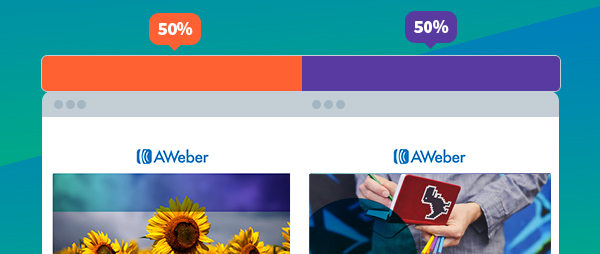
 We've rebuilt our split testing tool to help you send high-performing, effective emails. Testing can transform the way you send. It allows you to figure out what email content resonates best with your audience. You can test simple tweaks, like changing a call-to-action button color to drive more sales, re-writing a subject line to get more opens, or adding an image to increase engagement. You can also test bigger changes, like wildly different email copy, or varying send times.
We've rebuilt our split testing tool to help you send high-performing, effective emails. Testing can transform the way you send. It allows you to figure out what email content resonates best with your audience. You can test simple tweaks, like changing a call-to-action button color to drive more sales, re-writing a subject line to get more opens, or adding an image to increase engagement. You can also test bigger changes, like wildly different email copy, or varying send times.
How it works
- Varying subject lines
- Pre-header text
- Email designs or templates
- Images vs. GIFs vs. no images
- Body copy
- Call-to-action text or placement
- Background and button color variations
- The actual time you send the message
What AWeber users are saying
We built this feature using feedback from AWeber users like you! Over the past few months, we rolled out split testing to a small group of customers. "This split testing feature is great," says Rob Wood, founder of Light Stalking, a popular photography blog. After just one subject line split test, Rob saw "a noticeable impact on traffic" — a 33% increase! — to his site from his newsletter. In our own tests, we’ve been driving more opens and clicks as well! We have tested short vs. long subject lines and emojis vs. no emojis on our blog newsletter.Here are six tests you can run today
Looking for ideas on what to test? We have you covered. Head on over to this fresh blog post where our conversion content pro, Liz Willits, reveals SIX awesome test ideas you can set up in 1 minute.Get ready to test!
This month, we roll out more split testing posts, case studies, and videos. We'll even do a live webinar (be on the lookout for an invitation your inbox in the next couple weeks). Split testing has the power to transform your email marketing. Get started today, subscribe to our newsletter, and stay tuned for more inspiration and education. Check out all of our product updates from 2018! September: Tag a Bunch of Subscribers at Once August: Awesome Sign Up Forms and a New GoToWebinar Integration July: Create Modern, Sleek Emails Faster than Ever July: Visualize your Campaigns performance with our mobile app June: AWeber’s Customer Solutions Team is Now Available 24 Hours a Day, 7 Days a Week! May: Connect Your Email Marketing with More Than 100 New Apps April: Automation, Segmentation, Mobile App Updates, and More March: One-Click Automation and Segmentation February Product Updates: 5 NEW Features Have Hit Your AWeber Account ¡Atención! Connect with Your Audience in 13 Different Languages Push Notifications– Now Available in AWeber’s Stats App Ready to try AWeber free for 30 days? Let's get started.The post New: Split Test Your Emails in AWeber! appeared first on Email Marketing Tips.
from Email Marketing Tips https://ift.tt/2DvBl3h
via IFTTT
6 Email Split Tests You Can Set Up in 1 Minute

1. Headline vs. no headline
Does having a bold and colorful headline at the top of your email content grab your subscribers’ attention and keep them reading? To find out, send two emails — one with a eye-catching headline and one without a headline. For example, let’s say you’re a fitness blogger, and you’re sending an email about the five stretches you recommend before a workout. You could run a split test with one email variant that has no headline and one email variant with a headline at the top of the email content that says, “5 pre-workout stretches to prevent injuries.” Pro tip: Like the email template from the example above? It's called Wane Light and you can find it in your AWeber account. (Don't have AWeber? Try it out free for 30 days.)
Pro tip: Like the email template from the example above? It's called Wane Light and you can find it in your AWeber account. (Don't have AWeber? Try it out free for 30 days.)
2. Personal salutation vs. no salutation
Do your subscribers like to feel that your emails were written specifically for them? Run a split test to find out! Try using their first name in the salutation of your email (for example, “Dear John,” “Hi John,” “How’s it going, John,” etc.) and see if you get a higher click-through rate. You can also incorporate someone’s name at the end of a sentence or in another natural (yet unexpected!) place in your email.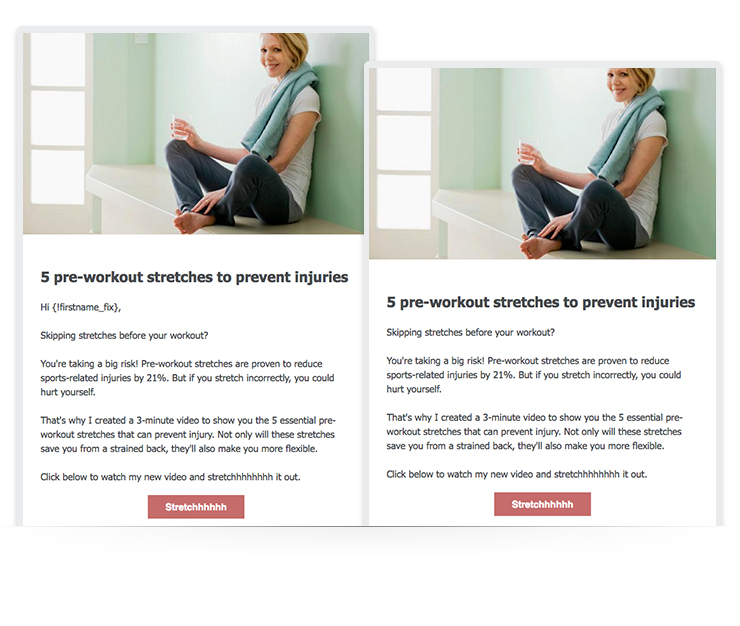 Pro tip: If you have an AWeber account, you can easily add a first name to your email subject line or content to personalize your messages.
Pro tip: If you have an AWeber account, you can easily add a first name to your email subject line or content to personalize your messages.
3. Images vs. no images
Are your subscribers visual people that like images in their emails? Or, do images distract them from your content and call-to-action? Create a split test where one email variant has an image and the other does not. Compare the results of your test and find out which your audience prefers.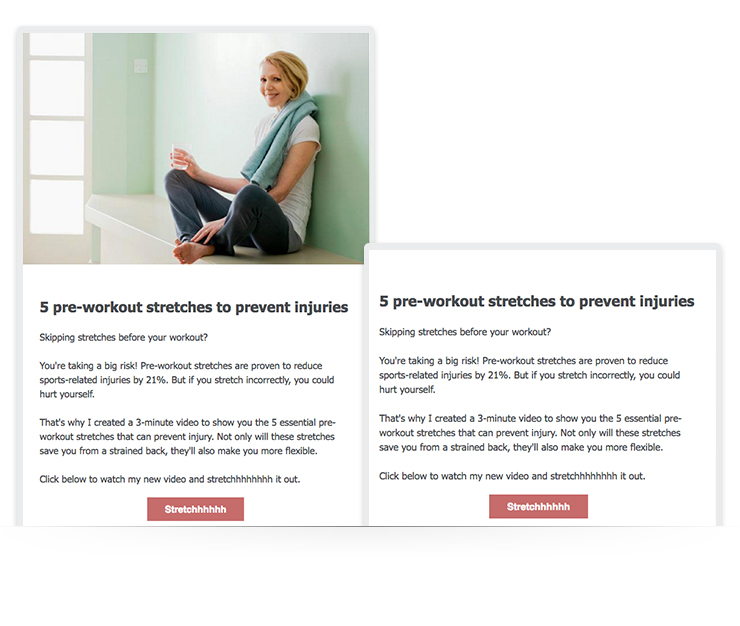 Related: How to Create Amazing Photos for Your Emails on Zero Budget
Related: How to Create Amazing Photos for Your Emails on Zero Budget
4. Long content vs. short content
Perhaps your subscribers like short emails that get straight to the point. Or, maybe they need more information before they’re ready to make a decision. Find out with a split test that compares two email copy variants:- a lengthy email that describes all the details of your offer
- a short and easily digestible email that summarizes the same information
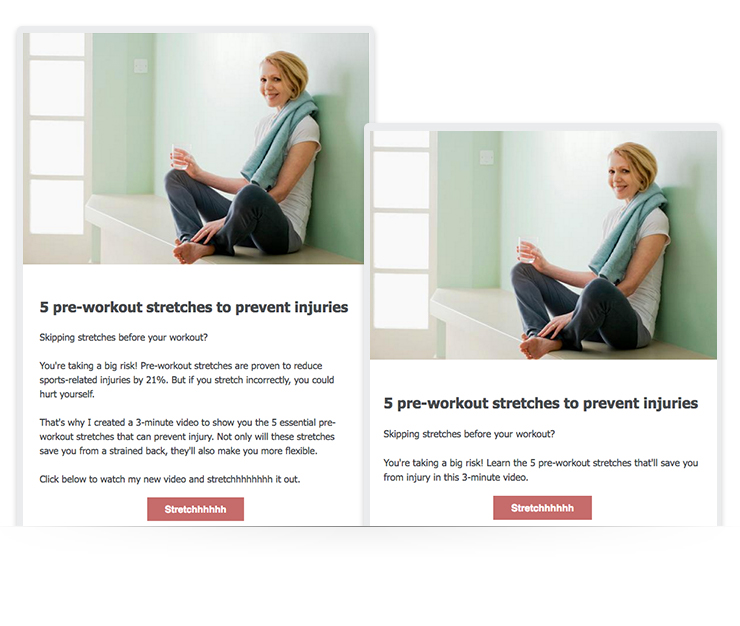
5. P.S. vs. no P.S.
Since subscribers often skim emails, including a P.S. at the end of your emails can be an effective way to boost your click-through rates. A subscriber might glance over your content, but carefully read the P.S. To see if this is true of your subscribers, send your first email variant without a P.S. and your second email variant with a P.S. at the bottom of your content.
6. Call-to-action button vs. hyperlinked text
Are your subscribers more likely to click on a button or hyperlinked text? If you don’t know, a split test is a great way to find out! After all, if your call to action (CTA) isn’t optimized, you’re missing out on valuable clicks. Try two variations of an email — one with a button as a CTA and the other with hyperlinked text as a CTA. Just make sure to use identical text for both calls to action. Related: Why You Need to Split Test Your Emails (and 4 Best Practices to Get Started!)
Related: Why You Need to Split Test Your Emails (and 4 Best Practices to Get Started!)
Start split testing
Now that you have a few tests to start with, you can begin improving your emails and your bottom line. Ready to discover even more tests you can use to optimize your email marketing strategy? Check out our free Minimalist Marketer’s Guide to Split Testing to learn everything you need to know to become a split testing master.
The post 6 Email Split Tests You Can Set Up in 1 Minute appeared first on Email Marketing Tips.
from Email Marketing Tips https://ift.tt/2NBeI20
via IFTTT
Why You Need to Split Test Your Emails (and 4 Best Practices to Get Started!)

What is a split test?
Split testing (or A/B testing) is a method by which you can scientifically test the effectiveness of your email marketing. When split testing, you create two versions (called variants) of an email to determine which email statistically performs better. Once you find which email variant performs best, you can update your email strategy to include the winning email. This allows you to identify what emails engage your subscribers best, which can ultimately help you increase conversions and revenue.Why you need to test your emails
Split testing is an effective way to find out what’s working and what’s not in your email marketing. Rather than assuming your customers would prefer one kind of email over another, you can run a split test to find out in a methodical way. The more you split test, the more information you’ll have on hand for your future emails. And while a once-and-done test, or even an occasional test, can yield information that will expand your marketing knowledge, regular testing can provide you with a successful email marketing strategy. Related: 6 Email Split Tests You Can Set Up in 1 Minute4 best practices to get started
1. Test one element at a time.
Never test more than one change at a time. Have a control email that remains the same and a variant with one change — like a different color CTA button, or a different coupon offer — you want to test. If you have multiple variables, it’ll become difficult to identify which one caused a positive or negative result. For instance, let’s say you’re a blogger who writes about gardening. You decide to split test an email’s subject line to improve your open rates. The goal of your split test is to discover if longer, descriptive subject lines or shorter, direct subject lines perform better. You also want to see if including a subscriber’s first name in your subject line will increase your open rate. So you write two variant subject lines: Subject line #1: 3 Ways to Stop Weeds from Growing Before They Start Subject line #2: John, Stop Weeds Today. After looking over your analytics, you find that subject line #2 performs better. Great! But there’s a problem with your test: You don’t know why variant 2 performed better. Was it because of the first name? Or was it because the subject line was short and direct? To avoid this confusion, test one variable at a time.2. Have a plan.
Prioritize your tests. Run split tests for your most important and most frequently sent emails first. And know what you want to fix about your emails before you run tests. Struggling with low open rates? Try subject line tests. Stuck with low click-through rates? Test your call-to-action button copy. Create a split testing plan where you conduct one email split test a week or one email split test per month.3. Record your results.
Keep records of the email split tests you’ve performed, the results of those tests, and how you plan to implement your learnings. Not only will this keep you accountable for implementing changes, it will allow you to look back on what did and didn’t work.4. Keep split testing.
You are never done split testing. Why? Because even if you find something that may be true of your subscribers now (for example, they like shorter subject lines), that may not be true three months or a year from now. So keep testing. The more you refine your email strategy through split testing, the more you improve your emails — and your bottom line.Testing 1, 2, 3
Ready to discover even more split tests you can use to optimize your email marketing strategy? Check out our free Minimalist Marketer’s Guide to Split Testing to learn everything you need to know to become a split testing master.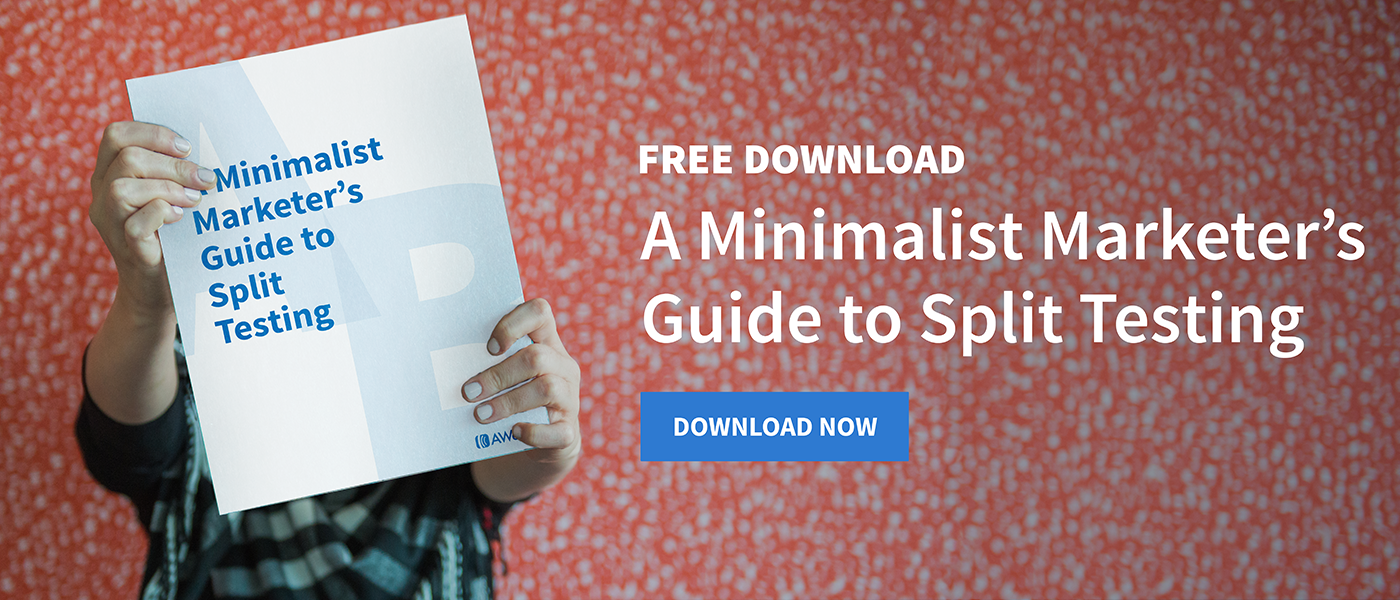
The post Why You Need to Split Test Your Emails (and 4 Best Practices to Get Started!) appeared first on Email Marketing Tips.
from Email Marketing Tips https://ift.tt/2DvE3pA
via IFTTT
The 3-Step Formula for Generating Email Leads from Speaking Gigs

1. Create a curiosity gap.
People tend to take action when they have a desire to achieve or learn something. You can create this desire (and use it grow your list) with a curiosity gap. A curiosity gap is when there is a void between what someone knows and what they want to know. And according to Port, it’s important to create one with every speaking opportunity you have because it’s what drives your audience to take action. To create a curiosity gap, answer the “what” and “why,” but don’t give your audience the “how” yet. You want them to think, “That sounds awesome! But how do I do that?" Here’s an example: A sign up form is a tool that allows you to easily collect subscribers. By optimizing your sign up form, you can triple your subscriber growth and double your revenue. By creating a curiosity gap, you’ve now piqued their interest. You’re ready to move to the next step: filling the gap with a tool or resource.2. Fill the gap with a tool or resource.
Once you’ve created a curiosity gap and your audience is looking for a solution, give them a tool or resource to fill the gap and satisfy their need or desire. (In step 3, we'll explain how to deliver this tool or resource to your audience from the stage.) When creating your tool or resource, Port suggests staying away from denser pieces of content, like ebooks, white papers, and reports. In his experience, these aren’t as effective at generating email leads from the stage because they are denser pieces, requiring much more time to consume. Audiences want content that are easier to digest. Instead, offer shorter tools, like tips, formulas, grids, calendars, and templates.These tend to convert more audience members into email subscribers. You could also test this theory with your own audience. Offer up a simple, easy-to-consume solution and another more in-depth, time-consuming solution. Different audiences will prefer different tools and resources. For instance, an audience of medical doctors may want a published research document or white paper. An audience filled with social media marketers may want a content calendar download. Continuing with the sign up form example from before, the “how” is: With my simple checklist, you can optimize your form in minutes. Port also recommends that you make sure your tool is specific to the lesson you’re teaching from the stage. And mention your tool a couple times during during your presentation, like halfway through and at the end. Related: 22 Brilliant Lead Magnets That’ll Inspire You to Grow Your Email List Right Now3. Build your list and nurture your audience member.
Now that you’ve introduced the tool or resource that’s going to fill your audience’s curiosity gap, you’re ready to invite them to subscribe to your list to get it. Building a list from the stage is different from building it online. Your audience likely won’t have their laptop ready to visit a website and opt in. And even if they did, typing in an address while they’re listening to your presentation is distracting. But what almost every audience member will have is a mobile device. That’s why you should use a tool like Call Loop, EZ Texting, Textiful or Join By Text to invite your audience to join your email list and receive the tool or resource you’re offering. Here’s how these tools typically work:- Ask your audience to text a phrase (e.g., OPTIMIZE) to a specific phone number (provided by the texting service you use).
- After your audience texts the phrase to the phone number, they will receive a response on their mobile device that asks them to respond with their email address.
- Once they respond with their email address, they will be added to your email list automatically and receive your welcome email.
Step up your speaking game at Heroic Public Speaking LIVE
Need more help with your public speaking? Join Port and his team at Heroic Public Speaking LIVE, October 1 to 3 in Philadelphia, PA. The AWeber team will be there as a sponsor. Come meet up with us to learn how to use email marketing to reach and connect with your audience off stage. Not sure how to get more leads? Struggling to create a profitable email strategy? We can help. At AWeber, we’re not just an email marketing platform — we’re a team of email experts that want to see you succeed. You can contact us day or night to get all of your questions answered. Start your free 30-day trial of AWeber today.The post The 3-Step Formula for Generating Email Leads from Speaking Gigs appeared first on Email Marketing Tips.
from Email Marketing Tips https://ift.tt/2OQyDqz
via IFTTT
Sext-shaming won’t stop revenge porn — and it’s sexist

In an announcement made earlier this month, the Dutch police have called on adolescents to “stop sexting completely” in an attempt to tackle the growing issue of revenge porn. As we are now well into the #MeToo movement, this shows how institutions are still struggling to address issues of sexual consent and assault. However, telling young people to stop sexting doesn’t sound like a solution at all. It sounds like sext-shaming, and a lazy attempt at preventing the nonconsensual spread of nude images. There’s something very wrong with the way we talk to young people, especially girls, about sexting. Even though they…
This story continues at The Next Web
from Social Media – The Next Web https://ift.tt/2OOxoYP
via IFTTT
Monday 24 September 2018
Friday 21 September 2018
Thursday 20 September 2018
Instagram is testing a ‘regram’ feature to natively repost content

On Twitter there’s the retweet button. Facebook has the share icon. On Instagram, nothing. To date, users have had to get creative in their attempts to repost content from other accounts on to their own timelines. Some used third-party apps that were just as good, sometimes better, at stealing data and hijacking accounts as they were at actually sharing content. Others just downloaded or screenshotted the original, and then republished it to their own feed — hopefully with a citation to the original. For years, though, Instagram users have been asking for a native share feature, just like those available…
This story continues at The Next Web
Or just read more coverage about: Instagram
from Social Media – The Next Web https://ift.tt/2xGule2
via IFTTT
This startup wants to become the Facebook of death

Social media has changed how we live, and surprisingly, how we die. Mortality used to be an intimate affair shared between families and close groups of friends, but that’s no longer the case. People now broadcast the passing of their loved ones across the internet to an audience of potentially billions. This raises an interesting question: are social media platforms, which are rife with trolls and aggressive advertising, appropriate vessels for collective grieving? Mark Alhermizi, founder and CEO of Everdays, has his doubts. These concerns, combined with research that dragged him to funeral director conferences worldwide, led him to launch a…
This story continues at The Next Web
Or just read more coverage about: Facebook
from Social Media – The Next Web https://ift.tt/2xBvmE3
via IFTTT
Wednesday 19 September 2018
Your Start-to-Finish Plan to Getting 1,000 Email Subscribers

Craft a better email newsletter
First things first: To effectively grow your subscriber list, you want to make sure you’re always sending your best content. Before you send out your next email newsletter, it’s a good idea to take a step back and evaluate what’s currently working and what’s not. Related: How to Create an Irresistible Email Newsletter (Plus, 19 Newsletter Examples for Inspiration!) According to the Direct Marketing Association, the four most important email marketing metrics are:- Click-through rate (CTR)
- Conversion rate
- Open rate
- ROI
Get your emails in front of the right people
Now that you've refreshed your email newsletter, it’s time to make sure the right people see it. Here are a few tried and true tactics that you can put to the test to grow your subscriber list. (Not sure how to get more leads? Struggling to create a profitable email strategy? We can help. AWeber isn't just an email marketing platform — we're a team of email experts that wants to see you succeed. You can contact us day or night to all your questions answered. Start your free 30-day trial today.)1. Tap your connections and current subscribers
Leveraging your network is a great way to steadily increase your subscriber list, and often the best place to gain traction especially in the beginning. Although some of your connections may not be interested in the material themselves, they might know someone who is. Reach out to current subscribers and encourage them to share your email with people they know who may be interested. You can make this ultra-simply by including a link for quick sharing within your email. (Basically, you're asking them to forward your content on to those who may enjoy it!) Here's a fantastic email example of how to ask your connections to share your content. Use it as a template for your own outreach. Pro tip: According to QuickSprout, subscribers are 3x as likely to share content on social media than visitors who view your content through other sources. Make sure your content is easy for subscribers to share with their social networks as well.2. Include CTAs across your channels
It’s no secret that calls-to-action are essential when helping customers take the next step. The same rings true for bulking up your subscriber list. Add a CTA to sign up for your email newsletter within each of your blog posts and on your website. Also, pinning a post with the link to sign up to all your social profiles will help make it easier for potential subscribers to see.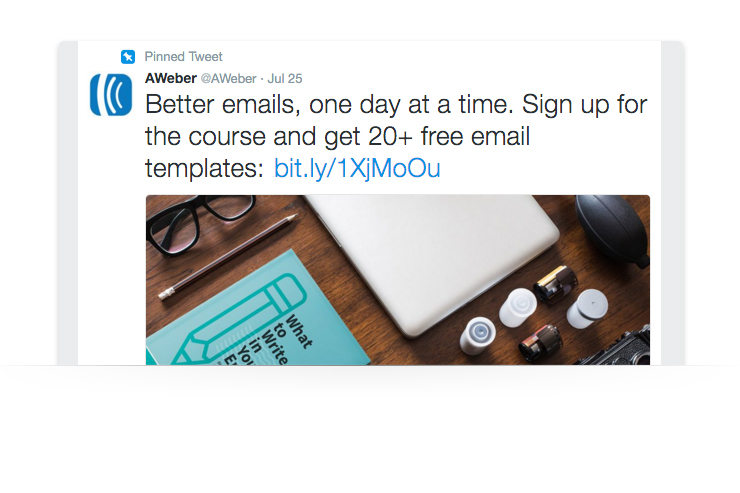 Providing as many opportunities to make signing up a breeze will increase the likelihood of more users subscribing.
Providing as many opportunities to make signing up a breeze will increase the likelihood of more users subscribing.
3. Invest in social advertising
Social media is a powerful tool, especially when backed by a few bucks. It can help you reach your target audience thanks to ad formats that cater to email signups. For example, this Twitter ad from Really Good Emails is eye-catching, yet simple.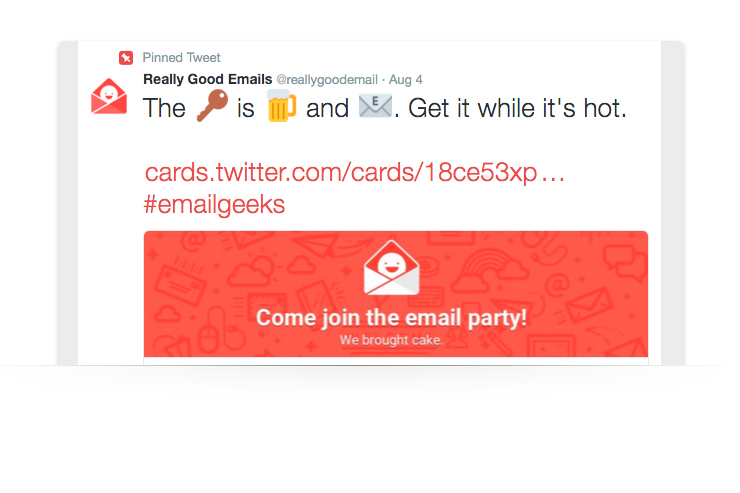 This playful Twitter ad not only aligns with their brand, but it clearly tells users what to do next. Don’t be afraid to play around with your ads and test different creative and copy. Like email marketing, the only way to understand what resonates with your audience is to test, test, test! And don't limit yourself to just Twitter. For instance, you could put an image of your newsletter in your Instagram Story and ask your followers to "swipe up" to join your email list.
This playful Twitter ad not only aligns with their brand, but it clearly tells users what to do next. Don’t be afraid to play around with your ads and test different creative and copy. Like email marketing, the only way to understand what resonates with your audience is to test, test, test! And don't limit yourself to just Twitter. For instance, you could put an image of your newsletter in your Instagram Story and ask your followers to "swipe up" to join your email list. 
4. Write for other industry blogs
Guest writing is a great way to reach an audience you otherwise might not have the chance to. It seems unlikely that you would be able to increase signups for your email newsletter on another site, right? The truth is: You definitely can. In addition to the valuable content you’re already providing in the guest post, include a link to a dedicated landing page that offers more free content with no catch. Just be sure to include a CTA for visitors to sign up for your email newsletter. AWeber customer Noah Kagan from OkDork did just that and was able to increase his subscriber list: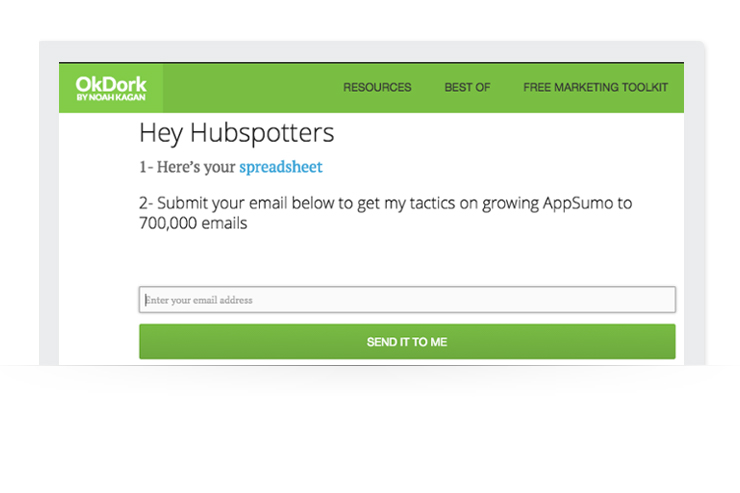 With guest writing, you not only provide value to a new audience, but you also have the opportunity to find subscribers who might become some of your best customers. Related: Understanding the Marketing Funnel: 5 Strategies to Improve Your Email Marketing
With guest writing, you not only provide value to a new audience, but you also have the opportunity to find subscribers who might become some of your best customers. Related: Understanding the Marketing Funnel: 5 Strategies to Improve Your Email Marketing
5. Monitor and track your email performance
A sure-fire way to ensure you reach your goal of 1,000 subscribers — or any marketing goal for that matter — is to monitor the performance of your emails and adjust where needed. Make sure you have the correct tracking in place on both your email newsletters and your website. The data you collect will allow you to identify top-performing content and inform decisions that help evolve your email newsletters, which will result in more subscribers. It’ll also help you find out which lead generation methods are producing the most impactful results. To keep things simple (and free!) start with a tracking tool like Google Analytics that can help you watch your numbers and gauge performance. You can set this up in just a few minutes and start gathering in-depth analytics around your email and website traffic. Without the ability to track key metrics, it will be difficult to understand how your readers are interacting with your content and what they likely want to see more of in the future.Wrap up
If you’re not quite where you want to be yet regarding your subscriber count, don’t get discouraged. There are many ways to boost your lists — just remember, it can take time to attract the right audience. Wouldn’t you rather have 1,000 engaged subscribers than 10,000 uninterested ones? Get started building your email list today with our FREE Email List Growth Blueprint course.The post Your Start-to-Finish Plan to Getting 1,000 Email Subscribers appeared first on Email Marketing Tips.
from Email Marketing Tips https://ift.tt/2MGwAU1
via IFTTT
ACLU says Facebook ads allow employers to favor men over women
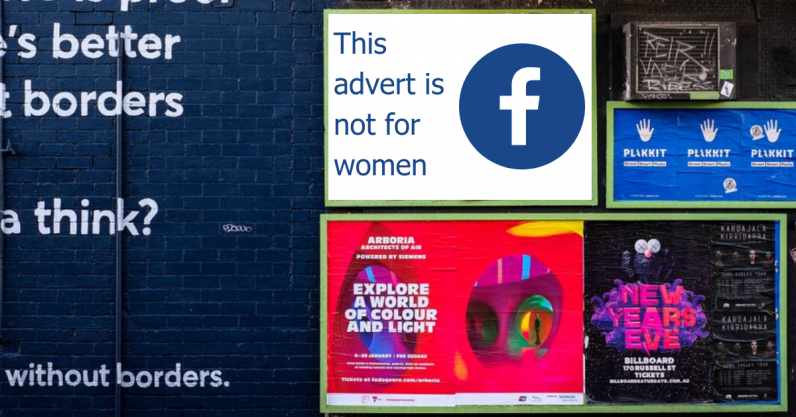
On Tuesday, the American Civil Liberties Union (ACLU) submitted a complaint to the US Equal Employment Opportunity Commission (EEOC) against Facebook. It claims the platform’s ad options have allowed employers to post adverts that allow discrimination based on gender. “Facebook has created and profited from a powerful tool for discrimination against female and other non-male job applicants,” the complaint explains. ACLU’s complaint was filed on behalf of three female job seekers after they were not shown advertisements for what have been traditionally considered male-dominated professions — including roles such as mechanic, roofer, and security engineer. How does Facebook’s ad-targeting system work?…
This story continues at The Next Web
Or just read more coverage about: Facebook
from Social Media – The Next Web https://ift.tt/2piXsA8
via IFTTT
Tuesday 18 September 2018
New in AWeber: Tag a Bunch of Subscribers at Once!
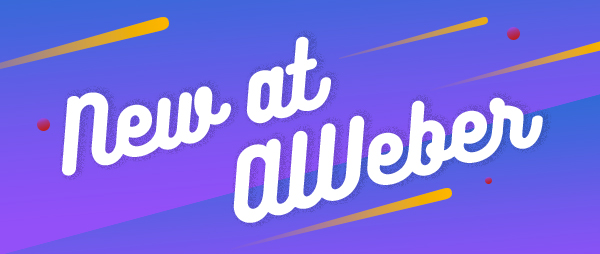
What you need to know about tags:
- You can now search for anyone that meets certain criteria and tag them all at once. For example, you can tag subscribers who haven’t opened in the past 30 days, anyone who clicked on a certain link, or those added from a certain webform. The possibilities are limitless. 🔖
- Tags also integrate with AWeber’s automation platform Campaigns, so you can trigger an automated sequence of emails to send to a specific segment. 🚀
How to take advantage of bulk tags:
- Watch the brief demo video above to see a quick overview of AWeber's bulk tag feature. 🎥
- Begin bulk tagging and creating segments in the "Manage Subscribers" page of your AWeber account.
- Check out our Knowledge Base article for more details on exactly how to bulk tag your subscribers.
Want to learn more about tags?
Join me on Monday, September 24 at 11 AM EST for an overview of tags in AWeber. We’ll cover the basics and benefits, answer any questions you might have, and show you how to get started using tags and bulk tags inside AWeber. Can't attend? Register anyway and I'll send you the recording. Check out all of our product updates from 2018! August: Awesome Sign Up Forms and a New GoToWebinar Integration July: Create Modern, Sleek Emails Faster than Ever July: Visualize your Campaigns performance with our mobile app June: AWeber’s Customer Solutions Team is Now Available 24 Hours a Day, 7 Days a Week! May: Connect Your Email Marketing with More Than 100 New Apps April: Automation, Segmentation, Mobile App Updates, and More March: One-Click Automation and Segmentation February Product Updates: 5 NEW Features Have Hit Your AWeber Account ¡Atención! Connect with Your Audience in 13 Different Languages Push Notifications– Now Available in AWeber’s Stats App Ready to try AWeber free for 30 days? Let's get started.The post New in AWeber: Tag a Bunch of Subscribers at Once! appeared first on Email Marketing Tips.
from Email Marketing Tips https://ift.tt/2OBxClQ
via IFTTT
Friday 14 September 2018
This Sales Pro Wrote Outreach Emails for 15 Years. Here Are His Best Email Tips

The Most Important Lesson of Sending Outreach Emails
When I first started out in sales 15 years ago, my outreach emails were also ineffective at driving action. I was wasting my time writing messages that ended up in people's trash folders. That was, until I learned one important lesson: The true goal of any email outreach is to build meaningful relationships with the person you’re hoping to contact. It isn't to bombard them with offers until they magically decide to purchase from or collaborate with you. Once I realized this, my outreach emails started to get opened. Since then, I've scored business opportunities with everyone from startup founders to Fortune 500 executives. I’ve figured out what works and what doesn’t. That's why I put together relationship-building email templates inside our product at Close.io. These templates help hundreds of thousands of sales professionals increase their open rates, start more conversations, and drive more sales. So whether you’re looking to secure a spot as a contributor for a major online publication, book yourself on someone else’s podcast, or land your next big client, outreach emails are a necessity in today's business world. Follow my 5 tips below to learn how to effectively write them so they don't end up in someone's trash folder. (Heads up: An outreach email is different than email marketing. You send an outreach email to a single recipient who has no prior relationship with you. Email marketing, on the other hand, is a message sent to a mass audience that has opted-in to receive your content.)1. Use mutual connections
Did you know that 92 percent of people trust referrals and recommendations that come from people they know? When sending outreach emails, remember that you’re probably not the only one emailing with a similar request. (Let alone the only one pitching them that very same day.) So whenever possible, leverage your personal or professional connections who have a more direct relationship with your intended recipient. Then, ask them to make an introduction. Related: How to Get Your First 50 Subscribers in Less Than 30 Days I recommend researching your recipient's LinkedIn profile to find mutual connections. You can also follow them on Twitter to see if you have any followers in common. If they have a blog, check out who contributes as a guest. If they have a podcast, see who they’ve interviewed. You may just uncover a common connection. You’re not always going to have a mutual connection that can just fire off a quick intro, so look to see who you might build connections with that could influence your target recipient.2. Write the world’s most intriguing subject lines
Surprisingly, 47 percent of people decide whether or not an email is worth reading based on the subject line alone. At most, you have a little over a second to make them want to open your message. Try to create as much intrigue as possible. You want your reader to think, “Really? Why?” as soon as they read your subject line. While there are a variety of ways you can do this, in my experience the easiest way to create intrigue is to either challenge a commonly held belief they may have, or simply ask them a question. Here are several examples of effective, intriguing subject lines:- Interested in being on my podcast, [first name]?
- Can I feature you in an upcoming blog post?
- Are you looking for speakers for [name of event]?
- Why I think you're the perfect person for my next podcast
- I want to run an idea by you, [first name]
- Question for you, [first name]...
- I surveyed my audience, and they asked for you...
- I just had [name of influential person] on my show... care to jump on as well?
3. Personalize your email and get to the point quickly
When sending outreach emails, remember that you’re hoping to speak with one specific person, which means you want to personalize your pitch as much as possible. In my own inbox, I always see emails with paragraphs of text about the company’s mission and values, and why they’d be so perfect to work with. The reality is that most professionals don’t care about that—and they have no reason to. The only thing prospects care about is how you can help them. For example, if you want to secure someone on your blog, podcast or webinar, be sure to include the following in your outreach email:- Introduction
- Why you’re reaching out to them (what type of partnership or opportunity are you pursuing?)
- What’s in it for them (e.g., How many readers will see their blog post on your website; How many leads they can expect by being a guest on your webinar or podcast)
- How you’ll help promote them and their business throughout the partnership
- Why your audience is the right fit for them.
- Make the ask
- Introduction
- Why you’re reaching out to them (what type of partnership or opportunity are you pursuing?)
- What value you can provide to their audience (e.g., education, service, products, etc.)
- Why you have the right experience to be featured on their site or show (e.g., give examples of other blogs, podcasts or webinars you’ve contributed to in the past)
- Make the ask
- Introduction
- Why you’re reaching out to them
- Show you've done your research (highlight something you both have in common, like an alma mater or a past work colleague, or highlight something they've worked on recently that you enjoyed)
- Make the ask
4. Nurture ALL contacts
One of the most frustrating aspects of email outreach is deciding your best course of action when a recipient doesn’t engage with your messages. The reasons for a recipient dropping off the map could be numerous — maybe they don’t have the time right now, they just never bothered to reply, or they’re simply not interested and haven’t explicitly told you that. Whatever the reason, you may be tempted to shrug your shoulders, write them off in order to pursue a new opportunity, and never follow up with them again. But that’s one of the biggest mistakes you can make. According to a Rutgers University study of 224 executive MBA students who reached out to dormant connections—people they hadn’t spoken to in at least three years—for help with an important project, researchers found that not only were the dormant contacts useful, but they were often more helpful than active connections. The study further suggests that the novelty of seeing an old friend, previous co-worker or former classmate pop back into your inbox, tends to spur people into taking quicker (and more enthusiastic) action than with existing relationships that already have an ongoing value exchange. Related: How to Find Your Customers' Pain Points This means you shouldn’t abandon an opportunity as soon as they stop replying to your messages or even after they say they’re not interested at this time. Instead, take a relationship selling approach and keep the opportunity on file for quarterly check-ins. Just because someone says, ‘Not right now’ or drops off the radar today, doesn’t mean they won’t be a good fit a few months down the line. Since the last time you got in touch, their circumstances (or yours) may have changed, and you may be able to better address their past objections. Before you begin sending outreach emails to every dormant connection you have, consider the fact that they might not remember you from that one conversation you had over a year ago. Treat them as a new prospect again. Always begin your reconnection email with a quick reminder of how you met or where you worked or collaborated together. Establish a clear context around why you're reaching out today.5. Use other channels beyond email
Despite the fact that 86 percent of business professionals prefer to use email when they communicate for business-related purposes, be wary of relying on email too much in your outreach. For some people, email might not be their preferred channel of communication and you’ll have a better chance of getting their attention if you speak to them over the phone, in person, or on social networks like LinkedIn or Twitter. If your prospect doesn’t respond to email, try one of the following:- Follow them on Twitter and send them a DM.
- Send them a message on LinkedIn.
- Private message them on Facebook.
The key to successful email outreach
Targeted email outreach is an effective way to create and nurture opportunities that can help you grow your business to new levels. The key to successful email outreach is to focus on creating conversations and building relationships without the immediate expectation of a quick transaction. If you can do this, you’re well on your way to email outreach success. Not sure how to get more leads? Struggling to create a profitable email strategy? We can help. At AWeber, we're not just an email marketing platform — we're a team of email experts that want to see you succeed. You can contact us day or night to get all of your questions answered. Start your free 30-day trial of AWeber today.The post This Sales Pro Wrote Outreach Emails for 15 Years. Here Are His Best Email Tips appeared first on Email Marketing Tips.
from Email Marketing Tips https://ift.tt/2NJW7jC
via IFTTT
Thursday 13 September 2018
Tuesday 11 September 2018
Study: Even those who get their news via social media don’t trust it
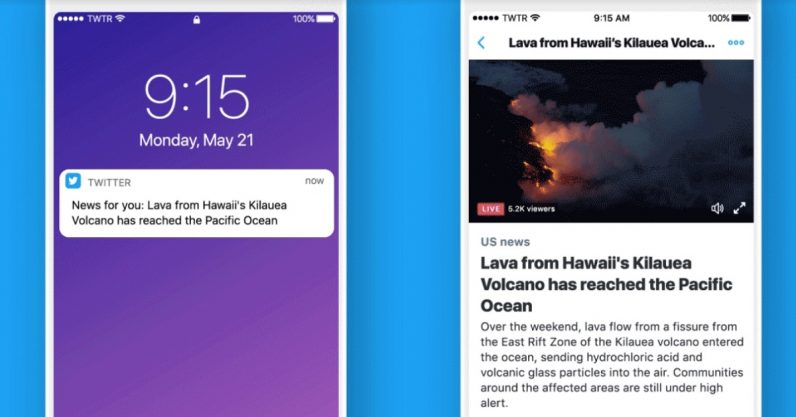
A Pew study published this week shows at least two-thirds of the country gets some of their news from social media, but by and large they still don’t trust it to be accurate. Pew’s study validates what you probably already suspected based on your friends’ activities: Two-thirds of the country gets its news from social media at least some of the time. That said, the study also shows that a majority expect the news to be “largely inaccurate,” suggesting a healthier dose of skepticism than one might suppose. In fact, of those who get their news on social media, 42…
This story continues at The Next Web
from Social Media – The Next Web https://ift.tt/2NAz2zO
via IFTTT
We ranked LinkedIn execs on how ‘LinkedIn’ their LinkedIn profile pics are

Look, LinkedIn sucks. You know it, I know it, even humans grown in huge Matrix-style vats somehow intrinsically grasp that LinkedIn. Is. Not. A Good. Thing. But, like with other Bad Things (think bros, country music fans, and nazis), LinkedIn has its own particular and peculiar aesthetic. This is perfectly encapsulated in one circular inch of pixels on almost every page of the site. We’re talking, of course, about the famed LinkedIn photo. During an office conversation, we got to thinking: what do the LinkedIn profiles photos of LinkedIn execs look like? How LinkedIn are they? Are they the most…
This story continues at The Next Web
Or just read more coverage about: LinkedIn
from Social Media – The Next Web https://ift.tt/2x6qpTc
via IFTTT
Monday 10 September 2018
Saturday 8 September 2018
We used Google Arts & Culture’s selfie app to make the internet’s Shit Museum

Ever have one of those weeks where you feel like everything is going wrong in the world? Us too. The planet is melting. There are powerful idiots all over the world with their greasy fingers hovered over big red doom buttons. Our favorite celebrities have dumb opinions we don’t agree with and choose to share them. And again someone finds a severed toe in their Big Mac. This week seemed especially long, which a lot of people saying stupid things we disagree with, so we decided to round up the worst of the worst. We used the Google Arts & Culture’s Art…
This story continues at The Next Web
Or just read more coverage about: Google
from Social Media – The Next Web https://ift.tt/2MbHml0
via IFTTT
Friday 7 September 2018
California law would make political bots illegal – unless they admit they’re bots

A California Senate bill awaiting Governor approval would make it illegal to create and operate a social media “bot” for the purpose of influencing a political vote or obtaining money unless it was made explicit that it was a bot. The bill, California SB 1001, was introduced by state Senator Robert Hertzberg. He’s a Democrat, but the bot problem isn’t specific to any political party. On any given day you can find hundreds – if not thousands – of suspicious social media accounts stirring up controversy. Last year A Russian troll farm was identified by US law enforcement investigators as…
This story continues at The Next Web
from Social Media – The Next Web https://ift.tt/2MWacuL
via IFTTT
Thursday 6 September 2018
Twitter has permanently banned Alex Jones and Infowars

Twitter has announced it’s permanently suspended the accounts of conspiracy theory website Infowars and its controversial founder, Alex Jones. In addition, Twitter has banned Jones and Infowars from its livestreaming service, Periscope, where Jones regularly broadcast and boasted a large following. A post on the Twitter Safety account said the company took the action as a response to content posted yesterday after the much publicized senate hearing involving Facebook and Twitter. Today, we permanently suspended @realalexjones and @infowars from Twitter and Periscope. We took this action based on new reports of Tweets and videos posted yesterday that violate our abusive…
This story continues at The Next Web
Or just read more coverage about: Twitter
from Social Media – The Next Web https://ift.tt/2CovegA
via IFTTT
Counterpoint: ‘All men are trash’ is hate speech

When I woke up this morning I didn’t think I’d start my day off defending white male privilege. But there’s an “all men are trash” discussion playing out on TNW’s social media accounts, and I have some thoughts. Trigger warning: This article contains detailed commentary with examples of some of the absolutely horrifying things women are forced to put up with online. Those sensitive to discussions which include mention of topics such as rape and violence may wish to avoid reading further. One of my colleagues at TNW recently published an article highlighting an Instagram account that displays examples of…
This story continues at The Next Web
from Social Media – The Next Web https://ift.tt/2wXArXV
via IFTTT
Facebook thinks saying ‘all men are trash’ is hate speech — it’s not

I recently wrote an article about an Instagram account that documents disturbing messages women receive on dating apps from men they’ve rejected. After it was posted on Facebook, it didn’t take long for the messages to roll in: “I call bullshit on this story,” “Women are con artists — if you do anything I don’t like I will bury you. MGTOW [Men Going Their Own Way] is the way,” and “Feminists should be burnt on a bonfire! Let the witch hunt begin!” Thanks guys… After this somewhat expected response from the friendly MGTOW community, our social media manager thought it…
This story continues at The Next Web
Or just read more coverage about: Facebook
from Social Media – The Next Web https://ift.tt/2MQUukL
via IFTTT